Abstract
Eutrophication is a long-standing ecological and environmental problem, and the severity of harmful algal blooms continues to increase, causing large economic losses globally. One of the most important hazards created by harmful algal blooms is the production of cyanotoxins. This study aimed to analyze the characteristics and development trends of cyanotoxin research through bibliometric analysis. A total of 3265 publications from 1990 to 2020 on cyanotoxins were retrieved from the Science Citation Index (SCI) Expanded database, Web of Science. Over the past 30 years, most research has been concentrated in China (21.4%) and the USA (21.3%). Throughout the study period, microcystin was the focus of the research, accounting for 86% of the total number of publications. A word frequency analysis revealed that as people became more aware of drinking water safety and the construction of large-scale water conservation facilities, “reservoirs” and “rivers” became hot words for researchers, while “lakes” have always been important research objects. Nonmetric multidimensional scaling (NMDS) analysis of studies from the five countries with the largest numbers of publications showed that Chinese researchers typically associate eutrophication with Microcystis, while research subjects in other countries are more extensive and balanced. The development of cyanotoxin research around the world is not even, and we need to push for more research on major lakes that are outside of North America, Europe and China.
1. Introduction
In recent decades, due to climate change and intensified human activities, inland water eutrophication has become increasingly severe, and the magnitude of harmful algae blooms (HABs) has increased [1,2]. HABs have seriously impacted the ecological landscape of water bodies as well as the safety of drinking water for humans and animals [3]. Moreover, HABs are prone to producing toxic secondary metabolites, i.e., cyanotoxins, which are usually released into environmental water bodies during the decay period of algae.
Cyanotoxins are divided into four categories: (1) hepatotoxins, (2) neurotoxins with tumor-promoting effects, (3) dermatoxins and (4) cytotoxins with specific biological activities [4,5]. Hepatotoxins are further divided into microcystins (MCs), nodularins (NODs) and cylindrospermopsins (CYNs) [6]. MCs are currently the most widely studied cyanotoxin [7]. They have a molecular structure with a cyclic heptapeptide (cyclo-(D-Ala-X-D-MeAsp-Y-Adda-D-Glu-Mdha)), where X and Y are variable [8]. At present, about 280 microcystin congeners [9], which differ in demethylation, hydroxylation, and polypeptide sequences, have been isolated and identified from different Microcystis strains. Among these congeners, MC-LR (X: leucine (L), Y: arginine (R)), MC-RR (X: arginine (R), Y: arginine (R)) and MC-YR (X: tyrosine (R), Y: arginine (R)) are the most common [10]. In view of the serious hazards of MCs to the safety of drinking water for humans and animals, the World Health Organization (WHO) set the limit of MC-LR in drinking water to 1 μg/L in 1998 [11], and the US Environmental Protection Agency (EPA) released a drinking water health advisory (10-day) for people of all ages [12]. However, many cyanobacterial peptides, such as cyanopeptolins, anabaenopeptins, aeruginosins etc. which can threat human and ecological health, have received little attention [13]. Recently, a research in the United States’ Great Lakes Basin found that concentrations of cyanopeptolins and anabaenopeptins in drinking water treatment facilities were equivalent to microcystins [14]. Furthermore, in European lakes, the researchers also detected all cyanopeptides [13]. With the continuous advancement of analytical scientific technology and the increasing enthusiasm of researchers for the study of cyanotoxins, more and more cyanotoxins will continue to attract the attention of researcher in the coming decades.
Cyanotoxins cause serious harm to human and animal health [15,16]. After consuming food or water containing cyanotoxins, humans and animals frequently experience stomach discomfort, vomiting, nausea, diarrhea, fever, sore throat, and other unpleasant symptoms. The conduction of cyanotoxins through food chains and the accumulation of toxins in different organisms also vary. For example, researchers have found that MCs can bioaccumulate in rice plants [17,18]. As an important food crop, rice is strongly related to human dietary health. Furthermore, contact between human skin and cyanotoxins in water during common activities such as bathing and swimming or other recreational or sporting activities can also cause skin allergies [19]. Since Francis et al. [20] first reported that animals died from drinking water containing cyanobacteria, there have been reports of large-scale diseases and deaths of birds, fish, livestock and even humans caused by cyanotoxins around the world. In 1975, the drinking water source of Sewickley, a small town in Pennsylvania, USA, was contaminated with toxic cyanobacteria, which eventually caused approximately 8000 people (62% of the local population) to suffer from acute gastroenteritis [21]. In 1996, in a Brazilian hemodialysis center, 116 of 130 patients had abnormal symptoms due to contamination of the dialysate with cyanotoxins, and more than 50 of patients eventually died [22]. Recently, 330 African elephants died suddenly in Botswana, Africa, and this incident has aroused global attention and concerns. Researchers have found through literature analysis that excessive cyanotoxins in waters on the African continent may be the direct cause of this tragedy [23].
Over the last three decades, the number of studies on the health problems associated with toxic cyanobacteria blooms as well as cyanotoxin detection and treatment methods have greatly increased. Several review papers have summarized the latest progress in research on cyanotoxins. Gartner et al. [4] proposed that researchers began to shift from studying toxin-producing algae in common environments to studying toxin producers in extreme habitats and collect a large number of samples from extreme habitats to facilitate extensive screening of cyanotoxins in these environments. Merel et al. [6] summarized the research status of cyanotoxins in various countries around the world and concluded the research hotspots of cyanotoxins at the time.
Nearly ten years have passed since the last bibliometric review paper on this topic was published, and the state of research on cyanotoxins is still a topic of concern. Moreover, following improvements in text analysis methods, a variety of text mining methods have been applied in bibliometric research, which allows for more comprehensive analyses of retrieved publications [24,25]. Understanding how studies on cyanobacterial blooms differ by region and whether all regions, especially relatively underdeveloped areas, have received enough attention may help improve local environmental health as well as prevent the occurrence of public health incidents. Here, we analyzed the characteristics and trends of cyanotoxin research from 1990 to 2020 through bibliometrics.
2. Materials and Methods
2.1. Search Strategy
The SCI Expanded database, Web of Science, was used in this study. This database is the world’s largest and most comprehensive academic information resource, covering the most disciplines. It contains a variety of core academic journals with the most influence in various research fields, such as natural sciences, engineering technology, and biomedicine. To cover the general subject of lake cyanotoxins, the following search strategy was used in this study: TS = ((microcystin* or Cyanotoxins* or nodularin* or cylindrospermopsin* or saxitoxin* or beta-N-methylamino-l-alanine* or anatoxin* or lyngbyatoxin* or aplysiatoxin*) and (lake* or river* or reservoir*)). The publication time period covered 1990 to 2020. The search was carried out on 10 November 2021. Since some of the search words appeared in only the keywords plus for the retrieved publications, we exclude this part of the search results [26]. For the retrieved results, we examined changes in the total number and distribution of publications on cyanotoxins around the world. Then, we summarized the characteristics of research on cyanotoxins in key nations over the course of several years. Finally, the geographical distribution of cyanotoxin research was summarized by scanning the abstracts of relevant publications.
2.2. Data Analysis
For additional analysis, document information such as the author, title, source (journal title), language, country/region, document type, author’s keywords and address, and topic category were downloaded. Articles from areas Hong Kong and Taiwan were not included in the Chinese category.
We used the information supplied in the abstracts to carry out the following analysis since abstracts comprised the primary information from each article. Abstract data from all publishers were used to develop word frequency statistics and finally generate extremely large sparse matrices using the R package “tm” [27]. The words with practical significance were identified from the top 50 keywords with the highest frequency. Relative importance (the rank of words in all vocabularies each year) was used to evaluate the changes in attention given to different words over the years [28]. The patterns of interannual variation in these phrases were tested using Mann–Kendall trend analysis [29]. The Mann–Kendall trend analyses were performed using “Kendall” [30].
The latent Dirichlet allocation (LDA) model [31] was used to analyze the research topics of the retrieved publications. Different from the topic classification of different types of articles on the Web of Science, the LDA topic model can help us understand the research topics of the retrieved publications. The LDA topic model analysis was carried out using the R package “seededlda” [32]. In the LDA analysis, the number of topics was set to 50, the 20 topics with the largest number of publications were selected; then, the 6 most frequent keywords were selected to draw a network diagram to better understand the relationships between topics.
To analyze the distribution of sites (i.e., lakes, reservoirs, and rivers) studied by publications related to cyanotoxins, we summarized the names of the lakes and reservoirs mentioned in the abstracts. We used the R package “stringr” to find the names of lakes by looking for the words before and after the keywords “Lake”, “River” or “Reservoir” and then manually searched for lake names [33].
Based on the generated sparse matrix, NMDS analysis was carried out using the R package “vegan” [34]. To use each article as a row vector, we collected keywords as column vectors to create a very large sparse matrix. For the formed sparse matrix, we choose words with a sparsity greater than 0.95 (a total of 39 words). In the NMDS results, we distinguished different countries and regions by color and shape to show the distribution characteristics of publications in different countries and regions. We used the nationality of the corresponding author as the country to which the article belongs.
Figures were drawn using the R package “ggplot2” [35], and network visualization was carried out with “igraph” [36]. The R package “RgoogleMaps” was used to query the latitudes and longitudes of lakes, reservoirs, and rivers that appeared in the summaries [37].
3. Results and Discussion
3.1. Variation in and Distribution of the Total Publication Number
A total of 3265 publications were retrieved through the search strategy described above. Most of the publications (2807) were related to microcystins, accounting for 86% of the publications, and 438, 292, 51, 382, 11, and 7 publications were related to cylindrospermopsin, saxitoxin, beta-N-methylamino-l-alanine, anatoxin, lyngbyatoxin, and aplysiatoxin, respectively. These results indicate that the research is still focused on microcystin. In fact, other types of cyanotoxins are also threatening the health of humans and animals [38,39,40]. To better promote the progress of cyanotoxin-related research, other types of cyanotoxin research should be given more attention. In addition to the search keywords that appeared in only keywords plus, there were 2905 related publications. Before 1996, the number of publications per year was less than 10. Subsequently, the number of publications increased rapidly each year, at an average annual rate of 12.4%, and 252 related publications were published in 2020 (Figure 1). Global warming has severely affected shallow reservoirs, releasing pollutants from sediments and accelerating eutrophication [41,42]. Researchers have found that temperature effects largely determine the distribution of different cyanotoxins in Europe [43]. The issue of cyanotoxins caused by the increasing number of algal outbreaks has attracted increasing attention from researchers. Therefore, in recent years, there has been an increasing number of publications related to cyanotoxins. The development of research on lake cyanotoxins in different countries and continents is mainly concentrated in developed countries. China and Brazil are the only two developing countries among the ten countries with the largest numbers of publications. Since 1999, the number of papers published on cyanotoxins has maintained a high growth rate in China. However, the proportion of publications on cyanotoxins suddenly dropped in 2020. This sudden decrease might be closely related to the healthy and stable economic development of China over the past 2 decades; however, the COVID-19 pandemic affected the ability of researchers to conduct field studies [44,45], which may be the main reason for the decrease in the proportion of Chinese publications on cyanotoxins in 2020. In Brazil, cyanobacteria blooms frequently occur in drinking water reservoirs. Brazilian researchers have developed a quantitative Polymerase Chain Reaction (PCR) method to provide early warning of possible cyanotoxin contamination of water bodies [46]. China, the United States, Germany, Canada, and Australia were the five countries with the largest numbers of published articles. Europe is also one of the regions with the highest number of publications, but it is not significant in the results when they were analyzed based on each country. The number of publications from China and the United States (698 and 696, respectively) was much higher than that from other countries (Figure 2). The publications from these five countries accounted for approximately 40% of the total number of publications. It should be noted that the number of publications on cyanotoxins from different countries is very uneven, and only 53 countries have more than 20 publications. In addition, many relatively poor countries still have not published any research on cyanotoxins, such as Angola, Zambia and Libya.
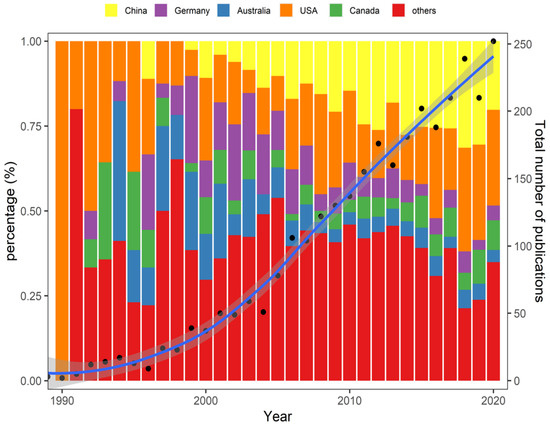
Figure 1.
Changes in the number of articles published each year and the proportion of the number of publications from the top five and other countries/areas with the most publications.
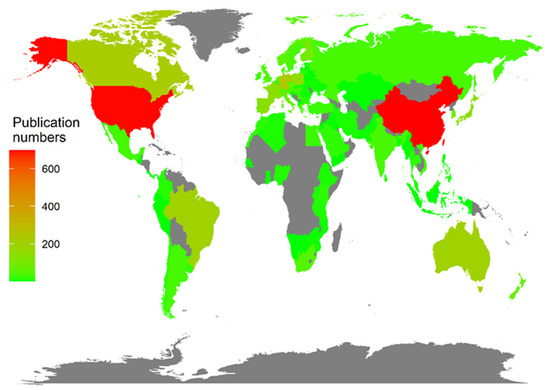
Figure 2.
Number of articles published by authors in different countries. Gray color represents areas without publications.
3.2. Characteristics of the Research Objects
The importance ranking of the number of occurrences of different words can help us understand the trends that researchers have paid attention to in recent years. The results of the relative importance analysis of word frequency are shown in Figure 3, the relative importance of words in the upper part of the figure show an upward trend (Figure 3a), and the lower part shows a downward trend (Figure 3b). The relative importance of “reservoir” and “river” has increased significantly in recent years (p < 0.001), while the frequency of occurrence of the word “lake” has not changed significantly (p > 0.5). This result shows that recently, researchers have paid more attention to reservoirs in the study of cyanotoxins. In particular, in recent years, the relative importance value of “reservoir” has been marginally lower than that of “cyanobacteria”, indicating that reservoirs are now dominating the research on this topic. This result might be influenced by two factors. First, reservoirs are increasingly used as sources of drinking water, and drinking water safety issues are always a priority. The increased importance of the terms “freshwater”, “human” and “health” also suggests that people are paying closer attention to drinking water safety. Second, as humans transform nature, there is a rapidly increasing amount of water conservation projects, reservoirs, and related sudies [47]. The term “gene” was first used after 2000, suggesting that genetic testing methods and other approaches were gradually included in cyanotoxin research after 2000. For example, researchers infer the toxigenic potential of a water body by detecting the presence of cyanotoxin-producing genes [48]. Cyanotoxin investigations frequently require the use of recipient organisms. The increased use of the keyword “fish” may indicate that more attention is being devoted to research on the interactions between fish and cyanotoxins. Cyanotoxins not only cause large-scale deaths of fish and destroy aquatic ecosystems but also enter the human body through food chains and cause adverse reactions in humans [49].
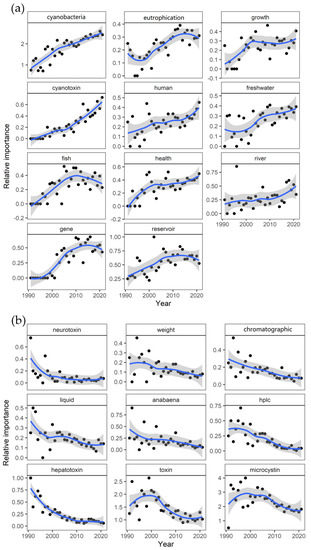
Figure 3.
The interannual changes in the relative rankings of the 20 words with practical meaning. (a) The upward trend of the relative importance of words. (b) The downward trend of the relative importance of words.
The prevalence of the terms “neurotoxin,” “hepatotoxin,” “toxin,” “microcystin,” and so on has diminished, demonstrating that the focus on various toxins has faded. Of course, this does not mean that researchers are unconcerned; rather, with the continued advancement of related research, the study of cyanotoxins will encompass an increasing number of fields. The research related to cyanotoxins is more comprehensive than it was in the past, which has led to a reduction in the relative importance of the words listed above. The relative prominence of terms associated with detection methods, such as “chromatographic” and “hplc”, has similarly declined, indicating that as cyanotoxin detection methods mature, researchers’ attention has shifted in recent years to focus on fast, efficient, easy-to-operate and portable biosensors [50,51] to facilitate on-site measurement in some remote locations.
In general, when researchers are conducting studies on the toxicity and removal methods etc. about cyanotoxins, they have also begun to study the possible impact of cyanotoxins on human health.
3.3. Research Characteristics of Cyanotoxins in Major Countries and in Different Years
The NMDS analysis results show that before 2000, due to the small number of published articles, the research focus changed greatly each year (Figure 4a). The increase in the number of studies related to cyanotoxins in the past ten years indicates that researchers have begun to concentrate on topics related cyanotoxins, with eutrophication as the primary focus. Among the countries with the largest numbers of published articles, the research contents of publications by authors from the United States, Germany, Australia and Canada are relatively similar, while the research content of publications by authors from China is mainly concentrated in the lower part of Figure 4b. Specifically, Chinese researchers prefer to associate eutrophication, nutrients, etc. with Microcystis, while the other four countries have more research on different types of cyanotoxins. In contrast, research from the United States covers a wider and more balanced set of relevant topics.
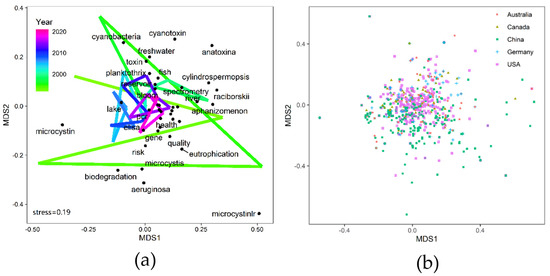
Figure 4.
NMDS analysis of abstract words. (a) The lines of different colors in the panel on the left indicate the connections between the mean values of the NMDS scores of publications in different years. (b) The points represent the point scores for publications from different countries.
The 20 topics found in the largest numbers of articles were selected for analysis (Figure 5). The results show that these topics were mainly divided into three categories. The first is category is the biological toxicity of cyanobacteria toxins. Such topics often appear in association with organs, evaluation, humans, health, etc. Another large category was mainly related to lake cyanobacteria blooms and cyanobacteria toxins. Such topics often include information on biomass, phytoplankton, community, and nutrients. The third category was mainly related to the determination of cyanotoxins. In this category, there were more words such as liquid phase, gene, method, and detection. The keywords that were more prevalent in earlier publications were freshwater, harmful, algae, bloom, and potential, which shows that early research may have focused on the potential harm of cyanobacterial toxins. Due to the recent rapid increase in the number of publications, these three categories of topics have attracted much attention and are common in recent publications.
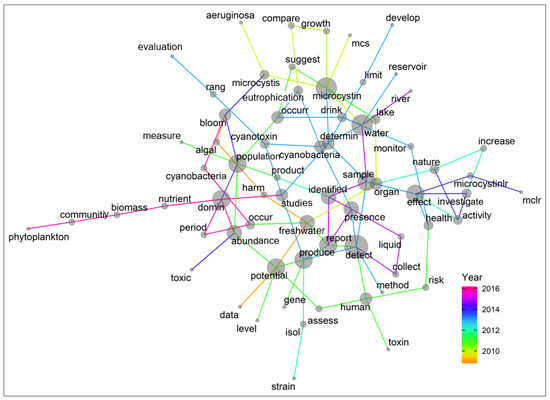
Figure 5.
Network diagram generated based on an LDA topic model.
3.4. Geographical Distribution of Research Sites
Of the 2106 publications, the abstracts of 1362 mentioned specific lakes, reservoirs, or rivers (LRRs). A total of 556 different LRR names were mentioned, including 285 lakes, 151 rivers and 122 reservoirs. These LRRs were mainly distributed in North America and Europe, while relatively few were located in Africa, Latin America, and South Asia (Figure 6). In fact, in relatively underdeveloped areas such as Africa and South Asia, water pollution may be more serious. For example, in a case that has recently attracted much attention, at least 330 African elephants (Loxodonta africana) in Botswana may have died from drinking cyanobacteria toxin-rich water [23]. Human activities have long been considered the main cause of eutrophication. However, in some underdeveloped areas, wild mammals such as hippos have contributed significantly to the nutrient load in freshwater ecosystems by foraging on land transferring nutrients from terrestrial ecosystems to aquatic ecosystems, making water bodies not affected by human activities highly eutrophic [52,53,54]. There are few data on the contents of cyanotoxins in lakes on the African continent. However, the detection of cyanotoxins is mainly performed by enzyme-linked immunosorbent assay (ELISA) [55] and high-performance liquid chromatography/mass spectrometry (HPLC–MS) [56,57]. These detection technologies have the advantages of fast detection speed and high accuracy; however, the high prices of the instruments and the demand for professional researchers are beyond the reach of some undeveloped countries. Although China ranks first in the number of publications related to cyanotoxins, its research sites are concentrated, mainly in the middle and lower reaches of the Yangtze River and the Yunnan-Guizhou Plateau, while cyanotoxin-related research sites in Europe and North America are more scattered, with research in different regions. Among the LRRs mentioned in the studies analyzed, Lake Taihu ranks first, with 146 related publications, followed by Lake Erie in the United States, which was mentioned in 46 publications. Lake Dianchi, Lake Chaohu, Lake Victoria, Lake Suwa, Lake Champlain, Yangtze River, and Nakdong River were each mentioned more than ten times. Among the nine most mentioned LRRs, China has three lakes and one river; this result may be driven by scientific research projects in China.
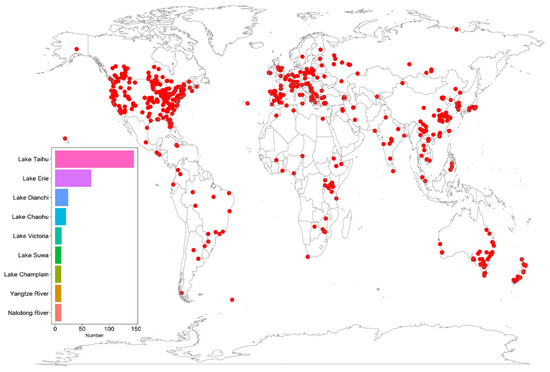
Figure 6.
The distribution and occurrence frequency of lakes, reservoirs, and rivers names in abstracts of retrieved publications.
The Taihu basin has developed industries, and its economy has maintained rapid growth. However, eutrophication caused by industrial development has become a major problem for the local government. In 2007, due to a large-scale outbreak of cyanobacteria, 2 million people living in the Taihu Basin in China suffered a drinking water crisis for at least one week [58]. Since then, with the investment of many scientific research funds, a major scientific and technological project on water pollution control has focused on eutrophication control in Lake Taihu. Lake Taihu is currently the lake receiving the most attention in the field of limnological research [59]. Cyanobacterial blooms in lakes in China are dominated by Microcystis [60], which is why, as shown in Figure 4b, cyanotoxin-related research in China focuses heavily on Microcystis. Although this concentration can promote research on cyanotoxins, for a country with serious eutrophication such as China, the problems created by cyanotoxins in many other lakes are also worthy of attention.
4. Conclusions
Statistics from relevant literature published from 1990 to 2020 show that research related to cyanotoxins has developed rapidly in recent years. Moreover, fields related to cyanotoxins are also expanding, attracting increasing attention from researchers. China and the United States are the two countries with the largest numbers of publications on cyanotoxins, with 698 and 696 papers, respectively. However, there are no publications relevant to cyanotoxins from some poor countries. Reservoirs and rivers have become hot words, indicating that people have begun to pay attention to topics such as drinking water safety and ecological health while building water conservation facilities such as reservoirs and dams. In China, the focus of researchers is relatively concentrated, with research mainly focused on MCs, while in countries such as Europe and the United States, more attention is given to different types of cyanobacterial toxins. At present, research on cyanotoxins has entered a new stage, although the amount of research on cyanobacterial toxins in many countries throughout the world is quite uneven. In the future, we should not pay too much attention to well-known lakes that receive large scientific research funds, such as Lake Taihu in China and Lake Erie in the United States. Instead, we should devote more research effort to relatively poor areas and carry out research on cyanobacterial toxins and their ecological effects.
Author Contributions
Conceptualization, S.Z. and J.W.; software, Y.M. and X.M.; investigation, X.H.; writing—original draft preparation, J.W.; writing—review and editing, S.Z. and J.W. All authors have read and agreed to the published version of the manuscript.
Funding
This research was funded by the Postgraduate Research &Practice Innovation Program of Jiangsu Province (KYCX21_0545), the Fundamental Research Funds for the Central Universities, and the World-Class Universities (Disciplines), and the Characteristic Development Guidance Funds for the Central Universities and National Natural Science Foundation of China (No. 51879084).
Institutional Review Board Statement
Not applicable.
Informed Consent Statement
Not applicable.
Data Availability Statement
Not applicable.
Conflicts of Interest
The authors declare no conflict of interest.
References
- Chorus, I.; Fastner, J.; Welker, M. Cyanobacteria and Cyanotoxins in a Changing Environment: Concepts, Controversies, Challenges. Water 2021, 13, 2463. [Google Scholar] [CrossRef]
- Cordeiro, R.; Luz, R.; Vilaverde, J.; Vasconcelos, V.; Fonseca, A.; Goncalves, V. Distribution of Toxic Cyanobacteria in Volcanic Lakes of the Azores Islands. Water 2020, 12, 3385. [Google Scholar] [CrossRef]
- Hu, L.; Shan, K.; Huang, L.; Li, Y.; Zhao, L.; Zhou, Q.; Song, L. Environmental factors associated with cyanobacterial assemblages in a mesotrophic subtropical plateau lake: A focus on bloom toxicity. Sci. Total Environ. 2021, 777, 146052. [Google Scholar] [CrossRef] [PubMed]
- Gartner, G.; Stoyneva-Gartner, M.; Uzunov, B. Algal Toxic Compounds and Their Aeroterrestrial, Airborne and other Extremophilic Producers with Attention to Soil and Plant Contamination: A Review. Toxins 2021, 13, 322. [Google Scholar] [CrossRef]
- Falconer, I.R. An overview of problems caused by toxic blue-green algae (cyanobacteria) in drinking and recreational water. Environ. Toxicol. 1999, 14, 5–12. [Google Scholar] [CrossRef]
- Merel, S.; Villarin, M.C.; Chung, K.; Snyder, S. Spatial and thematic distribution of research on cyanotoxins. Toxicon 2013, 76, 118–131. [Google Scholar] [CrossRef]
- Michelline, K.; Lin, T.F. Microcystin-LR Biodegradation by Bacillus sp.: Reaction Rates and Possible Genes Involved in the Degradation. Water 2016, 8, 508. [Google Scholar]
- Botes, D.P.; Tuinman, A.A.; Wessels, P.L.; Viljoen, C.C.; Hammond, S.J. The structure of cyanoginosin-LA, a cyclic heptapeptide toxin from the cyanobacterium Microcystis aeruginosa. J. Chem. Soc. Perkin Trans. 1984, 1, 2311–2318. [Google Scholar] [CrossRef]
- Bouaicha, N.; Miles, C.O.; Beach, D.G.; Labidi, Z.; Djabri, A.; Benayache, N.Y.; Nguyen-Quang, T. Structural Diversity, Characterization and Toxicology of Microcystins. Toxins 2019, 11, 714. [Google Scholar] [CrossRef] [Green Version]
- Corbel, S.; Mougin, C.; Nélieu, S.; Delarue, G.; Bouaïcha, N. Evaluation of the transfer and the accumulation of microcystins in tomato (Solanum lycopersicum cultivar MicroTom) tissues using a cyanobacterial extract containing microcystins and the radiolabeled microcystin-LR (C-14-MC-LR). Sci. Total Environ. 2016, 541, 1052–1058. [Google Scholar] [CrossRef]
- WHO. Guidelines for Drinking-Water Quality; World Health Organization: Geneva, Switzerland, 1998; pp. 281–283. [Google Scholar]
- Abbas, T.; Kajjumba, G.W.; Ejjada, M.; Masrura, S.U.; Marti, E.J.; Khan, E.; Jones-Lepp, T.L. Recent Advancements in the Removal of Cyanotoxins from Water Using Conventional and Modified Adsorbents-A Contemporary Review. Water 2020, 12, 2756. [Google Scholar] [CrossRef]
- Janssen, E.M.L. Cyanobacterial peptides beyond microcystins—A review on co-occurrence, toxicity, and challenges for risk assessment. Water Res. 2019, 151, 488–499. [Google Scholar] [CrossRef] [PubMed]
- Beversdorf, L.J.; Rude, K.; Weirich, C.A.; Bartlett, S.L.; Seaman, M.; Kozik, C.; Biese, P.; Gosz, T.; Suha, M.; Stempa, C.; et al. Analysis of cyanobacterial metabolites in surface and raw drinking waters reveals more than microcystin. Water Res. 2018, 140, 280–290. [Google Scholar] [CrossRef] [PubMed]
- Wood, R. Acute animal and human poisonings from cyanotoxin exposure—A review of the literature. Environ. Int. 2016, 91, 276–282. [Google Scholar] [CrossRef]
- Bownik, A. Harmful algae: Effects of alkaloid cyanotoxins on animal and human health. Toxin Rev. 2010, 29, 99–114. [Google Scholar] [CrossRef]
- Cao, Q.; Steinman, A.D.; Yao, L.; Xie, L. Increment of root membrane permeability caused by microcystins result in more elements uptake in rice (Oryza saliva). Ecotoxicol. Environ. Saf. 2017, 145, 431–435. [Google Scholar] [CrossRef]
- Cao, Q.; Rediske, R.R.; Yao, L.; Xie, L. Effect of microcystins on root growth, oxidative response, and exudation of rice (Oryza sativa). Ecotoxicol. Environ. Saf. 2018, 149, 143–149. [Google Scholar] [CrossRef]
- Merel, S.; Walker, D.; Chicana, R.; Snyder, S.; Baures, E.; Thomas, O. State of knowledge and concerns on cyanobacterial blooms and cyanotoxins. Environ. Int. 2013, 59, 303–327. [Google Scholar] [CrossRef]
- Francis, G. Poisonous Australia lake. Nature 1878, 18, 11–12. [Google Scholar] [CrossRef] [Green Version]
- Sykora, J.L.; Keleti, G. Cyanobacteria and Endotoxins in Drinking Water Supplies. In The Water Environment: Algal Toxins and Health; Wayne, W., Ed.; Carmichael: Boston, MA, USA; Springer: New York, NY, USA, 1981. [Google Scholar]
- Pouria, S. Fatal microcystin intoxication in haemodialysis unit in Caruaru, Brazil. Lancet 1998, 352, 21–26. [Google Scholar] [CrossRef]
- Wang, H.; Xu, C.; Liu, Y.; Jeppesen, E.; Svenning, J.C.; Wu, J.; Zhang, W.; Zhou, T.; Wang, P.; Nangombe, S. From unusual suspect to serial killer: Cyanotoxins boosted by climate change may jeopardize megafauna. Innovation 2021, 2, 100092. [Google Scholar] [CrossRef]
- Kim, Y.H.; Levine, A.D.; Nehl, E.J.; Walsh, J.P. A bibliometric measure of translational science. Scientometrics 2020, 125, 2349–2382. [Google Scholar] [CrossRef]
- Liu, Y.; Avello, M. Status of the research in fitness apps: A bibliometric analysis. Telemat. Inform. 2020, 57, 101506. [Google Scholar] [CrossRef]
- Fu, H.-Z.; Wang, M.-H.; Ho, Y.-S. The most frequently cited adsorption research articles in the Science Citation Index (Expanded). J. Colloid Interface Sci. 2012, 379, 148–156. [Google Scholar] [CrossRef]
- Feinerer, I.; Hornik, K.; Meyer, D. Text mining infrastructure in R. J. Stat. Softw. 2008, 25, 1–54. [Google Scholar] [CrossRef] [Green Version]
- Peng, K.; Deng, J.; Gong, Z.; Qin, B. Characteristics and development trends of ecohydrology in lakes and reservoirs: Insights from bibliometrics. Ecohydrology 2019, 12, e2080. [Google Scholar] [CrossRef]
- Zhang, Y.; Cabilio, P.; Nadeem, K. Improved Seasonal Mann–Kendall Tests for Trend Analysis in Water Resources Time Series. Adv. Time Ser. Methods Appl. 2016, 78, 215–229. [Google Scholar]
- Mcleod, A.I. Kendall: Kendall rank Correlation and Mann-Kendall Trend Test. 2011. Available online: https://CRAN.R-pro-ject.org/package=Kendall (accessed on 5 January 2022).
- Blei, D.M.; Ng, A.Y.; Jordan, M.I. Latent Dirichlet allocation. J. Mach. Learn. Res. 2003, 3, 993–1022. [Google Scholar]
- Lu, B.; Ott, M.; Cardie, C.; Tsou, B.K. Multi-Aspect Sentiment Analysis with Topic Models. In Proceedings of the IEEE International Conference on Data Mining Workshops, Vancouver, BC, Canada, 11 December 2011. [Google Scholar]
- Wickham, H.; Studio, R. Stringr: Simple, Consistent Wrappers for Common String Operations. 2017. Available online: https://CRAN.R-pro-ject.org/package=Stringr (accessed on 5 January 2022).
- Simpson, G.L.; Solymos, P.; Stevens, M.; Wagner, H. Vegan: Community Ecology Package. Time Int. 2010, 6, 15–17. [Google Scholar]
- Wickham, H. Ggplot2: Elegant Graphics for Data Analysis; Springer Publishing Company: New York, NY, USA, 2009. [Google Scholar]
- Csardi, G.; Nepusz, T. The igraph software package for complex network research. Int. J. Complex Syst. 2006, 1695, 1–9. [Google Scholar]
- Loecher, M.; Ropkins, K. RgoogleMaps and loa: Unleashing R Graphics Power on Map Tiles. J. Stat. Softw. 2015, 63, 1–18. [Google Scholar] [CrossRef] [Green Version]
- Dordevic, N.B.; Simic, S.B.; Ciric, A.R. First identification of the cylindrospermopsin (cyn)-producing cyanobacterium Cylindrospermopsis raciborskii (woloszynska) seenayya & subba raju in serbia. Fresenius Environ. Bull. 2015, 24, 3736–3742. [Google Scholar]
- Moustaka-Gouni, M.; Hiskia, A.; Genitsaris, S.; Katsiapi, M.; Manolidi, K.; Zervou, S.-K.; Christophoridis, C.; Triantis, T.M.; Kaloudis, T.; Orfanidis, S. First report of Aphanizomenon favaloroi occurrence in Europe associated with saxitoxins and a massive fish kill in Lake Vistonis, Greece. Mar. Freshw. Res. 2017, 68, 793–800. [Google Scholar] [CrossRef]
- Elsaadi, O.; Cameron, A.S. Illness associated with blue-green-algae. Med. J. Aust. 1993, 158, 792–793. [Google Scholar]
- Rietzler, A.C.; Botta, C.R.; Ribeiro, M.M.; Rocha, O.; Fonseca, A.L. Accelerated eutrophication and toxicity in tropical reservoir water and sediments: An ecotoxicological approach. Environ. Sci. Pollut. Res. 2016, 25, 13292–13311. [Google Scholar] [CrossRef] [Green Version]
- Savadova-Ratkus, K.; Mazur-Marzec, H.; Karosien, J.; Kasperoviien, J.; Koreivien, J. Interplay of Nutrients, Temperature, and Competition of Native and Alien Cyanobacteria Species Growth and Cyanotoxin Production in Temperate Lakes. Toxins 2021, 13, 23. [Google Scholar] [CrossRef]
- Mantzouki, E.; Lürling, M.; Fastner, J.; De Senerpont Domis, L.; Wilk-Woźniak, E.; Koreivienė, J.; Seelen, L.; Teurlincx, S.; Verstijnen, Y.; Krztoń, W.; et al. Temperature Effects Explain Continental Scale Distribution of Cyanobacterial Toxins. Toxins 2018, 10, 156. [Google Scholar] [CrossRef] [Green Version]
- Tan, L.; Wu, X.; Guo, J.; Santibanez-Gonzalez, E.D.R. Assessing the Impacts of COVID-19 on the Industrial Sectors and Economy of China. Risk Anal. 2021, 42, 21–39. [Google Scholar] [CrossRef]
- Wang, F.; Wu, M. The Impacts of COVID-19 on China’s Economy and Energy in the Context of Trade Protectionism. Int. J. Environ. Res. Public Health 2021, 18, 12768. [Google Scholar] [CrossRef]
- Moraes, M.A.B.; Rodrigues, R.A.M.; Schluter, L.; Podduturi, R.; Jorgensen, N.O.G.; Calijuri, M.C. Influence of Environmental Factors on Occurrence of Cyanobacteria and Abundance of Saxitoxin-Producing Cyanobacteria in a Subtropical Drinking Water Reservoir in Brazil. Water 2021, 13, 1716. [Google Scholar] [CrossRef]
- Ali, T.; Xie, W. Pakistan needs more reservoirs, and fast. Nature 2018, 560, 431. [Google Scholar] [CrossRef] [Green Version]
- Ribeiro, M.S.F.; Tucci, A.; Matarazzo, M.P.; Viana-Niero, C.; Nordi, C.S.F. Detection of Cyanotoxin-Producing Genes in a Eutrophic Reservoir (Billings Reservoir, SAo Paulo, Brazil). Water 2020, 12, 903. [Google Scholar] [CrossRef] [Green Version]
- Clausing, R.J.; Losen, B.; Oberhaensli, F.R.; Darius, H.T.; Sibat, M.; Hess, P.; Swarzenski, P.W.; Chinain, M.; Bottein, M.-Y.D. Experimental evidence of dietary ciguatoxin accumulation in an herbivorous coral reef fish. Aquat. Toxicol. 2018, 200, 257–265. [Google Scholar] [CrossRef] [Green Version]
- Zhang, W.; Dixon, M.B.; Saint, C.; Teng, K.S.; Furumai, H. Electrochemical Biosensing of Algal Toxins in Water: The Current State-of-the-Art. Acs Sens. 2018, 3, 1233–1245. [Google Scholar] [CrossRef]
- Li, Z.; Li, X.; Jian, M.; Geleta, G.S.; Wang, Z. Two-Dimensional Layered Nanomaterial-Based Electrochemical Biosensors for Detecting Microbial Toxins. Toxins 2020, 12, 20. [Google Scholar] [CrossRef] [Green Version]
- Scheffer, M.; Jeppesen, E. Regime Shifts in Shallow Lakes. Ecosystems 2007, 10, 1–3. [Google Scholar] [CrossRef] [Green Version]
- Wang, H.J.; Wang, H.Z.; Liang, X.M.; Wu, S.K. Total phosphorus thresholds for regime shifts are nearly equal in subtropical and temperate shallow lakes with moderate depths and areas. Freshw. Biol. 2014, 59, 1659–1671. [Google Scholar] [CrossRef] [Green Version]
- Moss, B. Mammals, freshwater reference states, and the mitigation of climate change. Freshw. Biol. 2015, 60, 1964–1976. [Google Scholar] [CrossRef] [Green Version]
- Litaker, R.W.; Stewart, T.N.; Eberhart, B.; Wekell, J.C.; Tester, P.A. Rapid Enzyme-linked Immunosorbent Assay for Detection of the Algal Toxin Domoic Acid. J. Shellfish. Res. 2009, 27, 1301–1310. [Google Scholar] [CrossRef] [Green Version]
- Guzman-Guillen, R.; Prieto, A.I.; Gustavo Gonzalez, A.; Eugenia Soria-Diaz, M.; Camean, A.M. Cylindrospermopsin determination in water by LC-MS/MS: Optimization and validation of the method and application to real samples. Environ. Toxicol. Chem. 2012, 31, 2233–2238. [Google Scholar] [CrossRef]
- Trifiro, G.; Barbaro, E.; Gambaro, A.; Vita, V.; Clausi, M.T.; Franchino, C.; Palumbo, M.P.; Floridi, F.; De Pace, R. Quantitative determination by screening ELISA and HPLC-MS/MS of microcystins LR, LY, LA, YR, RR, LF, LW, and nodularin in the water of Occhito lake and crops. Anal. Bioanal. Chem. 2016, 408, 7699–7708. [Google Scholar] [CrossRef] [PubMed] [Green Version]
- Qin, B.; Zhu, G.; Gao, G.; Zhang, Y.; Li, W.; Paerl, H.W.; Carmichael, W.W. A Drinking Water Crisis in Lake Taihu, China: Linkage to Climatic Variability and Lake Management. Environ. Manag. 2010, 45, 105–112. [Google Scholar] [CrossRef] [PubMed]
- Zhang, Y.L.; Yao, X.L.; Qin, B.Q. A critical review of the development, current hotspots, and future directions of Lake Taihu research from the bibliometrics perspective. Environ. Sci. Pollut. Res. 2016, 23, 12811–12821. [Google Scholar] [CrossRef] [PubMed] [Green Version]
- Huo, D.; Gan, N.; Geng, R.; Cao, Q.; Song, L.; Yu, G.; Li, R. Cyanobacterial blooms in China: Diversity, distribution, and cyanotoxins. Harmful Algae 2021, 109, 102106. [Google Scholar] [CrossRef]
Publisher’s Note: MDPI stays neutral with regard to jurisdictional claims in published maps and institutional affiliations. |
© 2022 by the authors. Licensee MDPI, Basel, Switzerland. This article is an open access article distributed under the terms and conditions of the Creative Commons Attribution (CC BY) license (https://creativecommons.org/licenses/by/4.0/).